Healthcare panel recruitment entails specific challenges, such as understanding the healthcare market, finding hard-to-reach panelists, and navigating ethical difficulties.
Pro tip: The paperwork is not easy either.
But you’re reading the right article to solve those issues.
We’ll discuss how to identify target respondents, build your panel, and keep members engaged.
We’ll also analyze various incentives and ethical considerations, sharing our insider tips as a panel recruitment agency.
TL;DR:
- Challenges of Healthcare Panel Recruitment: Navigating complex healthcare markets, reaching diverse panelists, and ethical issues are key challenges.
- Understanding the Healthcare Market: Essential to recognize the varied needs of healthcare professionals (HCPs), patients with specific conditions, and caregivers. Geographical differences impact insights.
- Identifying Target Respondents: Conduct feasibility assessments, utilize social media and professional networks, and send personalized invitations. Empathy and appropriate incentives are crucial for engaging diverse groups.
- Recruitment Techniques: Partner with advocacy groups, attend patient-oriented events, use social media and paid media campaigns, and implement referral systems for expanding panel reach.
- Building and Managing Panels: Define clear research objectives, focus on quality over quantity, use digital recruitment strategies, and continuously assess panel effectiveness. Engage panel members with regular updates, incentives, and interactive content.
- Diversity in Panels: A diverse panel is vital for comprehensive insights. Implement targeted recruitment, inclusive survey designs, quota systems, community engagement, and continuous monitoring.
- Incentives and Ethical Considerations: Offer appropriate incentives (monetary rewards, gift cards, charitable donations) while being mindful of ethical concerns like informed consent, privacy, participant exploitation, and transparency of purpose.
- Conclusion: Successful healthcare panel recruitment requires understanding market nuances, empathy towards participants, diverse recruitment strategies, and ethical diligence. Companies like inBeat can provide expertise in creating effective, data-driven recruitment strategies.
Let’s start with the most challenging part:
1. Understanding the Healthcare Market
The healthcare market encompasses a wide range of groups with unique needs and perspectives.
A solid survey panel company must understand these groups to get quality surveys.
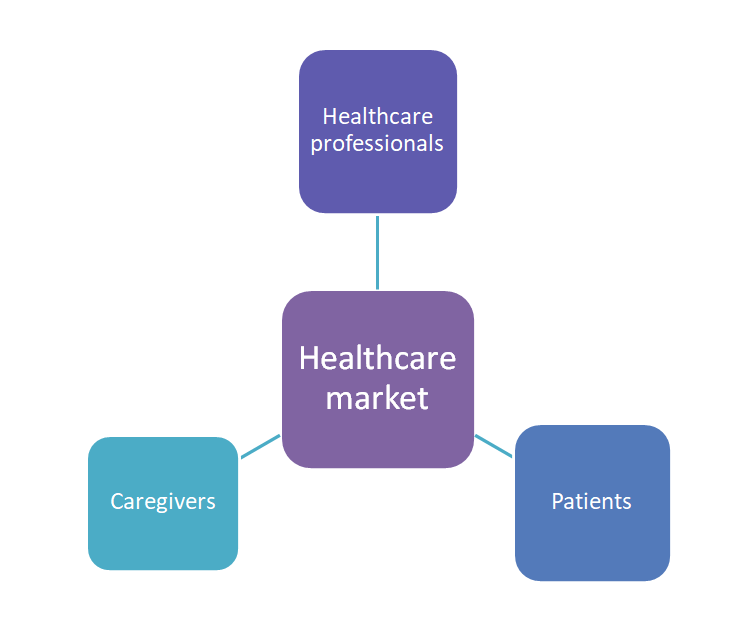
At the core are healthcare professionals (HCPs).
Their insights are crucial in shaping patient care and medical market trends.
However, HCPs are not just a monolithic group but a mosaic of specialists ranging from general practitioners to experts.
The patients are equally significant, particularly those with specific conditions.
These patients have specific insights opinion surveys need because they use tailored medical and support services.
Understanding their experiences and needs is vital for healthcare market research panels and market research studies, as it leads to more impactful insights that can transform patient care.
Insider tip: Geographical location is also essential. For example, in-depth interviews with patients from Latin America & US may offer survey panel companies other insights than those from Europe or Asia.
Caregivers, often the unsung heroes in healthcare, form another critical group.
Their firsthand experience in patient care provides invaluable insights for healthcare market research.
Leveraging online panels allows market research recruitment specialists to gather deep, AI-driven insights from these diverse groups. Of course, an analytics company may also decide that an offline panel is better for a specific market research study.
So, for example, if your research requires diabetes expertise, consider HCPs, patients, and caregivers with the right experience.
You should also find the best type of panel to interview them.
Insider tip: Market research in healthcare goes beyond mere data collection.
It’s about understanding the nuances of each group’s experiences and needs. Engaging a diverse panel of respondents gives market research firms high-quality insights.
2. Identifying Target Respondents
Now you know that market research firms like yours need a diverse panel.
Let’s see how you can find those health care professionals, caregivers, and patients in a cost-effective way.
We’ll specifically focus on a hard-to-reach target audience demanding a more intensive approach.

2.1. Conduct a Feasibility Assessment
Before beginning a market research project, conduct a feasibility assessment.
This process involves gathering information about the number of healthcare professionals (HCPs) treating a specific condition, the prevalence of that condition, and the usage rates of related drugs.
Insider tip: Resources like the National Institute for Health and Care Excellence (NICE) and the Digital NHS Catalogue can be invaluable in this stage.
2.2. Look in the Right Places
Identifying the right channels to reach target respondents is crucial.
Use support groups and social media platforms like Facebook or Instagram for patients and consumer audiences.
For customer care providers, professional networks like LinkedIn are more useful.
Insider tip: At inBeat, we use social media advertising based on specific criteria like age, gender, and location. It’s a cost-effective way to enhance the response rate and quality of market research panels.
2.3. Craft Personalized Invitations
The approach to inviting respondents is as important as finding them.
Personalized, detailed invitations explaining the study’s objectives, benefits, and procedures can significantly increase engagement.
Besides, a customizable experience effectively convinces healthcare professionals and patients to participate.
For studies involving niche areas or specific illnesses, like diabetes expertise, customization leads to a higher quality panel of authentic respondents.
2.4. Allow Sufficient Time for Recruitment
Any company with core expertise knows that recruitment can be time-consuming, especially for hard-to-reach groups.
Insider tip: Allow 4-6 weeks for recruitment, particularly for studies involving low-incidence diseases or specific patient criteria.
Healthcare professionals often have busy schedules, so advance notice and flexibility in scheduling are key to successful recruitment.
2.5. Putting Yourself in the Respondent’s Shoes
Empathy is essential in healthcare market research if you want impactful insights.
Understanding and accommodating the needs of respondents can significantly improve participation rates.
Insider tips: Consider organizing online panels or providing transport for those with mobility issues.
Allowing the presence of a carer may also get you agile insights from accurate participants.
You should also provide clear, comprehensive information about the study and use industry-standard tools.
This approach ensures the comfort and understanding of your respondents.
2.6. Ensure Appropriate Incentives
Offering suitable incentives can encourage participation from authentic respondents.
We’ll discuss more about this in a second.
But basically, the incentive should match the difficulty of recruiting the target group and comply with ethical guidelines.
Options include charitable donations, cash, shopping vouchers, or the intrinsic motivation of contributing to meaningful research.
Remember to ensure cost efficiency; also, health care professionals may require different incentives than patients or caregivers.
Insider tip: Understanding the specific needs of target respondents ensures your research is relevant, ethical, and effective.
Besides, you can get more accurate participants, boost their engagement, set better question types, and get more precise and actionable insights.
For example, consumer-only panel participant steps differ from those of a mixed panel, but it all starts with identifying authentic participants.
Tailoring research approaches based on these needs results in higher response rates and more valuable data for market research panels and healthcare market studies.
3. Recruitment Techniques
Now you’ve identified your panel participants, so let’s see which recruitment techniques you can try.
Remember that difficult-to-reach panelists require more intensive approaches.
By contrast, consumer audiences and people involved in customer care may benefit from a flexible approach.
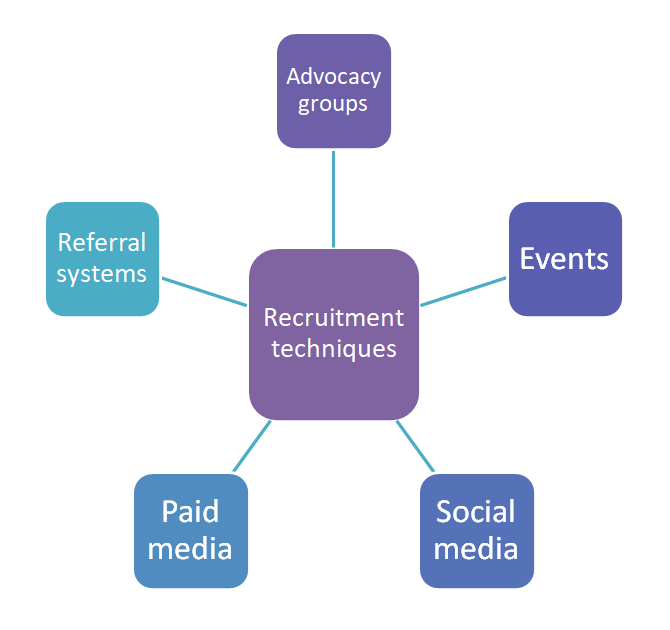
3.1. Partner with Advocacy Groups
Advocacy groups are great audience providers, particularly in the medical market.
These groups often have strong connections with patients and healthcare professionals, providing a quality panel for market research.
Plus, you’ll get these participants at competitive costs.
3.2. Attend Patient-Oriented Events
Patient-oriented events, such as health fairs or conferences, offer direct access to potential panel members.
It’s an effective way to connect with a wide range of audiences, from patients to caregivers and even healthcare companies that might attend.
3.3. Use Social Media and Paid Media
Social media platforms and paid media campaigns allow for targeted outreach to specific demographic groups, increasing the response rate for online panels.
These digital tools are essential for contemporary market research execution.
Insider tip: If you want insights from business owners in the B2B & healthcare field, use LinkedIn ads.
3.4. Implement Referral Systems
Referral systems are best, especially for consumer panels.
Basically, you’ll incentivize existing panel members to recommend others, expanding your panel’s reach.
This technique taps into personal networks, leading to high-quality insights at speed from diverse participants.
4. Building and Managing Panels
Building your panel correctly ensures your insights success.
But to get genuinely agile insights, you must keep your panel participants engaged throughout the process.
This section reveals 7 best practices to build your healthcare panel and 5 actionable techniques to manage it effectively.
Looking for a list of the top healthcare marketing agencies? Check out our recent post!
7 Best Practices in Panel Size Determination and Recruitment for Healthcare
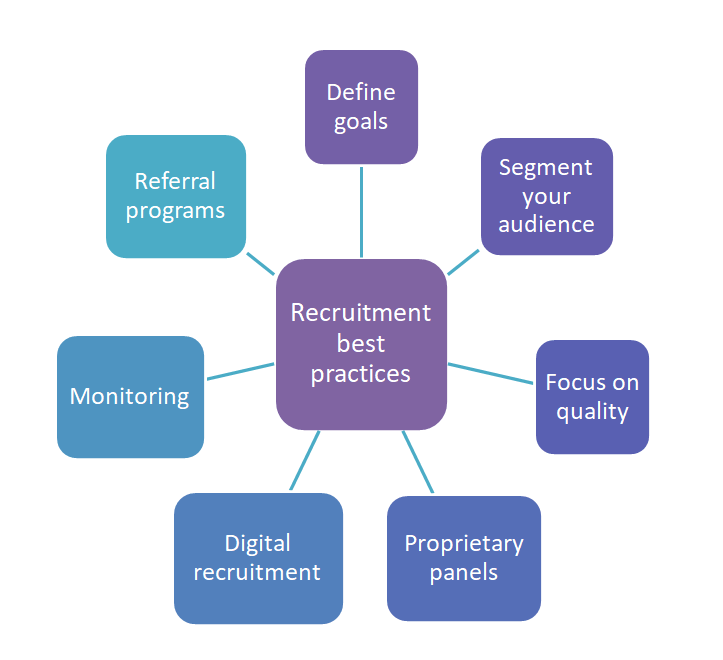
- Define Research Objectives: Clearly outline the goals of your healthcare market research to determine the necessary panel size and composition.
- Segment Target Audience: Identify specific groups within healthcare, such as healthcare professionals and patients with certain conditions, for targeted recruitment. Use AI-driven insights for optimal segmentation.
- Quality Over Quantity: Focus on recruiting high-quality respondents who are genuinely interested and knowledgeable rather than simply aiming for large numbers. For example, if you aim for employee insights, don’t target consumers as well. If you want insights from business leaders, target them specifically.
- Use Proprietary Panels: Consider using proprietary panels from a reliable panel provider for specialized healthcare segments. Market research recruitment specialists like inBeat have a data-driven, flexible approach to finding amazing panelists. Plus, we use industry-standard tools to zero in on accurate participants.
- Leverage Digital Recruitment: Employ online audience provider platforms and digital marketing strategies to reach a broader and more diverse audience at competitive costs. Again, inBeat takes the cake here, not just in terms of cost efficiency.
- Referral Programs: Implement referral incentives for existing panel members to attract new, relevant participants. This approach may not work for healthcare providers, but is a good way to build a consumer panel.
- Continuous Assessment and Adaptation: Regularly evaluate the panel’s effectiveness and make adjustments as needed to ensure it aligns with the evolving needs of the healthcare market. Consumer-only panel participant steps may be more flexible, but you must still monitor your panel’s performance constantly.
5 Techniques for Maintaining Panel Engagement and Communication
Building your panel is the first step; here’s how you can keep it engaged to get the human expertise you need.
1. Regular Updates and Feedback Requests
These are essential for maintaining transparency and showing panel members that their input is valued and impactful, leading to increased engagement and loyalty.
To implement this, you can send weekly newsletters updating on study progress and seeking feedback.
For example, you can send a survey to panel members asking for suggestions to improve the market research execution or to create a customizable experience.
2. Reward and Incentive Programs
These programs motivate continued participation and make panel members feel appreciated, which is key for sustaining long-term engagement.
Plus, you can get insights at speed.
One way to kickstart this is to develop a tiered reward system based on participation levels.
For instance, offer gift cards or exclusive content for consistent survey participation.
3. Personalized Communication
Customization enhances the relevance of communications for each panel member, creating a deeper connection and more meaningful participation.
Insider tip: Use data analytics to tailor communications to individual interests.
For instance, this will help you send personalized emails highlighting studies relevant to a member’s specific medical expertise.
4. Engagement Through Social Media
Use familiar platforms to create a sense of community among panel members, encouraging interaction and continued involvement.
For example, create a dedicated panel member community on platforms like Facebook.
Another good idea is to host live Q&A sessions on social media with experts in the healthcare market.
5. Interactive Content and Webinars
These tools provide value-added experiences, keeping panel members informed and engaged with the latest developments in the healthcare market.
You can organize educational webinars or podcasts on current healthcare topics exclusive to panel members, such as a webinar on the latest trends in patient care for healthcare providers.
Insider tip: Always prioritize the user experience in every interaction – whether in survey design, communication, or incentive offerings.
This approach improves response rates and creates a sense of community and loyalty among panel members.
5. Diversity in Panels
Whether you’re aiming for digital insights or will build an offline panel, you need diversity.
This section explains the benefits of ensuring said diversity and the step-by-step process of building a diverse panel.
Why Do You Need Diverse Panels?
Diverse panels address specific recruiting challenges in healthcare, such as:
- Limited Perspectives: Your research may be skewed towards dominant demographic groups. A diverse panel, however, brings varied viewpoints for more balanced and comprehensive insights. For instance, a study on diabetes management might overlook unique challenges faced by minority groups. However, including a mix of ethnicities and ages in the panel can reveal diverse management strategies.
- Underrepresentation of Rare Conditions: Unspecialized panel research companies may overlook rare medical conditions in research. However, actively recruiting patients with rare conditions can provide unique perspectives.
- Echo Chamber Effect: In some cases, research outcomes may reinforce existing beliefs due to homogenous groups, whereas the diverse panel solution introduces a range of opinions and experiences. For example, a panel of similar-aged healthcare professionals might have a biased view of new technologies. However, including professionals across age groups provides a balanced view of technological adoption.
How to Ensure Diverse Representation in Healthcare Panels
Follow the steps below to get a diverse healthcare panel and see our expert tips along the way.
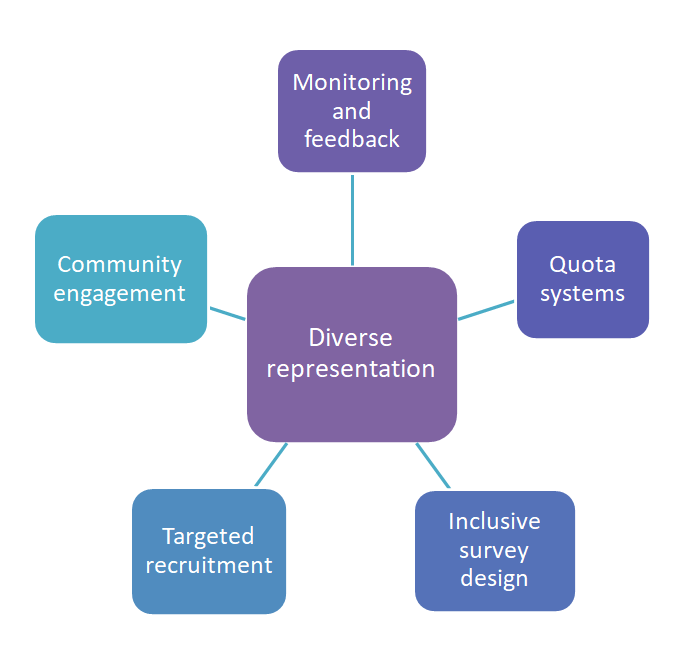
1. Targeted Recruitment Strategies
This entails focusing your recruitment efforts on underrepresented groups as well as dominant demographic groups to ensure a representative cross-section of the population.
Implementation:
- Identify underrepresented groups in your panel.
- Develop targeted outreach campaigns.
- Collaborate with organizations serving these groups.
Insider tip: Partner with community centers to reach minority communities. Or, create ads using healthcare influencers to attract online survey participants.
2. Inclusive Survey Design
Create surveys that are accessible and relevant to diverse groups, encouraging participation from a broader audience.
Implementation:
- Use inclusive and culturally sensitive language.
- Ensure surveys are accessible to those with disabilities.
- Test surveys with a diverse focus group.
Insider tip: Translate surveys into multiple languages for non-native speakers.
3. Quota Systems
This entails setting specific targets for different demographic groups, thus increasing diversity in panel composition.
For instance, you can allocate a certain percentage of the panel to elderly patients.
Implementation:
- Determine key demographics for your research.
- Set quotas for each group.
- Monitor recruitment to meet these quotas.
4. Community Engagement
Remember to build relationships with diverse communities.
This approach facilitates trust and increases willingness to participate.
Implementation:
- Identify key communities relevant to your research.
- Engage with community leaders.
- Participate in community events.
Insider tip: Attending health fairs in diverse neighborhoods is a good start to approaching a local audience.
5. Continuous Monitoring and Feedback
Review panel composition and seek feedback regularly to ensure ongoing diversity and responsiveness to change.
Implementation:
- Regularly analyze panel demographics.
- Conduct surveys to assess panel satisfaction.
- Adjust recruitment strategies based on feedback.
6. Incentives and Ethical Considerations
The best incentives allow you to easily fine-tune research.
But, you need the right compensation for each target audience. For example, getting more employee insights requires other strategies than healthcare & B2C representatives.
And, you should also watch out for legal and ethical problems.
6.1. Suitable Incentives for Panel Participants
Here’s how these incentives stack up against each other:
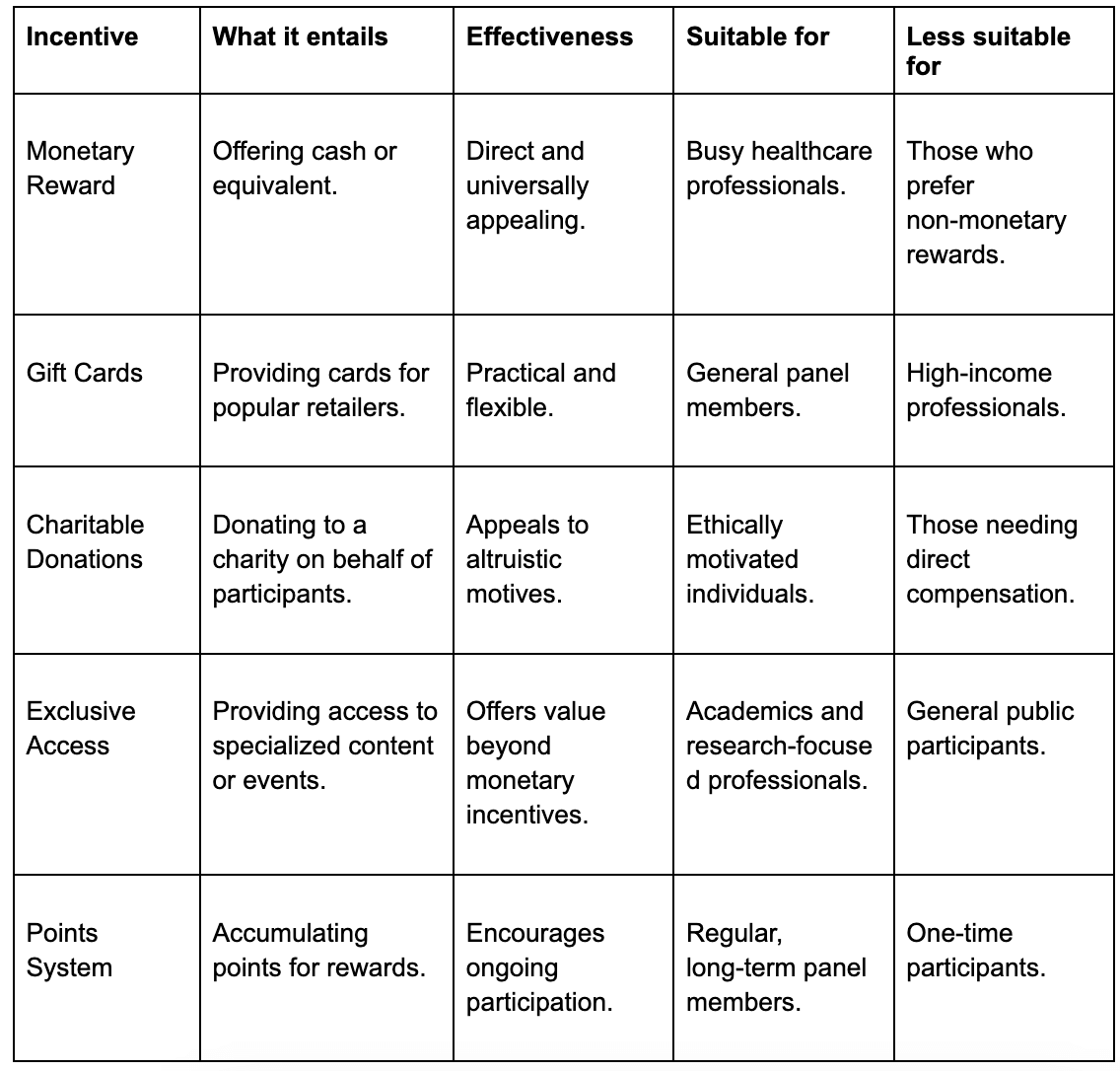
6.2. Ethical Concerns in Healthcare Panel Recruitment
As you can imagine, getting this human expertise from patients and medical professionals isn’t free of ethical concerns.
The most common challenges involve:
- Informed Consent: A major concern is ensuring participants fully understand the research. That’s because a lack of understanding can lead to unintentional exploitation. Using technical jargon in consent forms can cause this problem, so use clear, simple language and confirm understanding.
- Privacy and Confidentiality: Protecting sensitive health information should be a top priority because breaches can have serious consequences. So, avoid sharing data without proper anonymization; instead, implement strict data protection protocols.
- Participant Exploitation: Taking advantage of vulnerable groups, even unintentionally, results in unethical research practices. For instance, targeting low-income individuals with high incentives may be an issue. To avoid this, ensure equitable treatment and incentives.
- Transparency of Purpose: This entails being clear about research goals because misleading participants affects data integrity. One common example we’ve seen at inBeat is not disclosing commercial motives.
- Data Use and Sharing: Ethical handling of collected data is essential because misuse of data can harm participants. From that regard, selling data to third parties without consent is a big problem, so obtain consent for specific data uses and sharing.
Wrapping Up
As you can see, healthcare panel recruitment is a difficult task.
You can streamline the process by following the advice above.
Remember to ensure diversity and pick the right techniques to find your panelists.
Alternatively, you can pick a company with core expertise in panel recruitment, like inBeat.
We’ll build a data-driven strategy for finding the right panelists for your healthcare research, from A to Z.
Let’s set a free strategy call and find those personalized solutions together.

